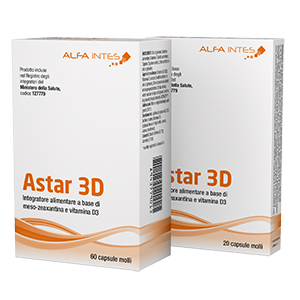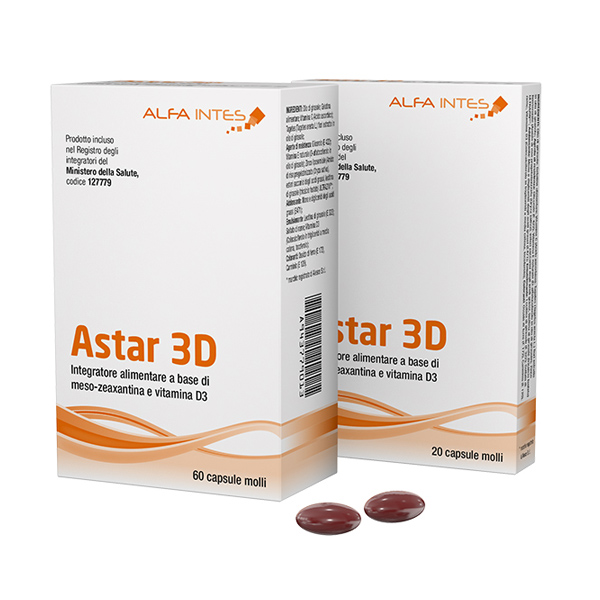Astar 3D
Age-related macular degeneration
Astar 3D is a food supplement based on three carotenoids (meso-zeaxanthin, lutein and zeaxanthin), vitamin D3, vitamin C, vitamin E, zinc and copper, specially designed for Age-Related Macular Degeneration (ARMD). ARMD is a multifactorial disease in which oxidative stress plays a leading role, both in onset and in progression.
Packaging: ASTAR 3D is available in packs of 20 and 60 capsules 


Info
Astar 3D is therefore indicated to help prevent the onset of ARMD, and to help slow the progression of the condition in cases where it has already been diagnosed. It guarantees a balanced and complete supply of substances which are naturally present in the retina and which serve to protect from the oxidative stress that acts as a triggering factor for this disease.
Faq
Meso-zeaxanthin, lutein and zeaxanthin belong to the carotenoid class and make up the macular pigment. Meso-zeaxanthin, lutein and zeaxanthin feature a double action mechanism: a direct one, as these carotenoids act as antioxidants against free radicals, and an indirect one, as the molecules selectively absorb harmful blue light. Clinical studies have shown that high concentrations of meso-zeaxanthin, lutein and zeaxanthin in the blood and in the retina are associated with a lower risk of degenerative eye diseases such as ARMD. Recent data have also shown that optimal and homogeneous concentrations of macular pigment can be achieved only through daily doses of formulations which contain all three macular carotenoids. This produces a signiicant improvement in contrast sensitivity.
Vitamin D3, also known as cholecalciferol, is extremely important for the body. Getting the required daily amount of this vitamin signiicantly reduces the risk of experiencing serious health problems. The human body’s main source of vitamin D3 is exposure to sunlight; a thermal process which takes place in the skin transforms a certain form of cholesterol into vitamin D3. The vitamin D3 produced in the skin then passes into the bloodstream and through the liverand kidneys, becoming transformed into its biologically active form. Clinical studies show that low levels of 25(OH)D (the main active form of vitamin D3) arecorrelated with late ARMD, suggesting that vitamin D3 may play a protective role in the progression of the disease. This beneit may be explained by the presence of speciic receptors for vitamin D in the retina, and by its anti-inlammatory and anti-angiogenic activity, which is already well documented. Therefore, vitamin D3 may have a part to play in preventing the onset and progression of ARMD by acting to control the inlammation and the processes which alter the structure of the retinal tissue. Vitamin C, or ascorbic acid, belongs to the water-soluble vitamin group: vitamins which cannot be stored in the body, but must be ingested regularly as part of the diet. Vitamin C is a powerful antioxidant which, thanks to its chemical and physical properties, is capable of neutralising all reactive oxygen species. Vitamin E, or tocopherol, is a fat-soluble vitamin which protects the cell membranes from oxidation and removes free radicals. It is stored in the liver, and therefore does not need to be ingested regularly in food. Rather, the body releases it in small doses as it is needed. The critical role that it plays in controlling damage from oxidative stress is highlighted by the serious harm caused by vitamin E deiciency (peripheral neuropathy, cerebellar ataxia, retinopathy, etc.).
Zinc and copper are essential trace elements: they contribute to the protection of cells from oxidative stress. Zinc also contributes to the maintenance of normal vision. An important clinical study has shown that taking zinc, in combination with other antioxidants, helps to slow the progression of ARMD. Based on the scientiic evidence, the EFSA (European Food Safety Authority) promotes these trace elements, together with some vitamins (C and E, for example), as substances genuinely capable of protecting us from damage from oxidative stress.
No, Astar 3D is gluten-free and lactose-free.
